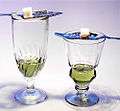Bartending/Drinkware/Glassware
< Bartending < DrinkwareGlasses are used to serve drinks in. Below are outlined some of the different glass styles you may see.
List of glasses
Beer
- Pint: A standard, all-purpose beer glass with slightly tapered walls. Used primarily for English- and American-style lagers and ales ranging from light lagers to imperial stouts. Pint glasses come in two sizes: Imperial 20 ounce (570 mL) or US 16 ounce (470 mL) pints.
- Pilsener: A long, narrow glasses with walls that taper towards the base. Used to consolidate volatiles and support delicate heads of pilseners and other lagers.
- Weizen: A large, curvaceous glass, bulbous near the mouth to support and showcase the heads of weizens and other wheat beers.
- Seidel: A German-style mug, often of great volume, with handles and thick walls to help maintain a cool temperature. An earthenware, ceramic, or metal version is called a stein.
- Tulip: A bulbous glass with a trumpeted mouth and short stem used to capture aromas and support large heads of artisanal Belgian ales. They are ideal for swirling beer to release volatiles. Many have etchings on the bottom of the inside of the glass to stimulate carbonation, aiding in head retention. A tulip glass may be substituted with an oversize snifter.
- Chalice or goblet: A wide-mouthed, bowl-like, stemmed glass, often with metal linings. Used for serving Trappist ales and other abbey-style ales. Like tulip glasses, they are often etched to stimulate carbonation. Chalices may be substituted with an oversize red wine glass.
.svg.png) Pint Glass (Mixing)
Pint Glass (Mixing).svg.png) Pint Glass (Pub)
Pint Glass (Pub).svg.png) Pilsner Glass (Standard)
Pilsner Glass (Standard).svg.png) Pilsner Glass (Footed)
Pilsner Glass (Footed).svg.png) Pilsner Glass (Weizen)
Pilsner Glass (Weizen).svg.png) Seidel
Seidel.svg.png) Goblet Glass (Schooner/Chalice)
Goblet Glass (Schooner/Chalice)
Brandy Snifter/Balloon
Similar to a wine glass, the brandy glass has a shorter stem and a wider bowl. The purpose is opposite of the wine glass — the brandy glass is designed to be cupped in the hand to warm the brandy.
.svg.png) Brandy Snifter
Brandy Snifter
Rocks
Often referred to as 'Rocks' glasses, Casablanca glasses are used in professionally and domestically globally due to their sturdiness, versatility and cheap pricing. Their distinctive octagonal shape comes as a result of the mold involved in the fabrication process. Today Casablanca glasses are the go-to functional glass for the average bartender in place of fashion when preparing, mixing and serving beverages. They can come in a wide range of sizes but the most common being:
- 5oz - Juices, Minerals and Dining
- 7oz - Liquor Sipping Glass, Bomb Glass
- 10oz - Versatile Glass, Often a Standard for Mixers, Half Pint Equivalent for Beers
- 13oz - Also "Cooler" Glass, Traditionally Gin & Tonic, Long Island Ice Tea or other Similar Cocktails
- 15oz - Fits Well Into Most Boston Tins, Ideal for Large Drinks, Cocktail Preparation and Serving
Cocktail
- Martini
- Double cocktail
- Hurricane
- Margarita
- Poco/Piña Colada
- Champagne/Daiquiri saucer
- Whiskey Sour
- Zombie
Cocktail and whiskey sour glasses are 4 fl oz (120 mL) glasses used for cocktails and whiskey sours. Martinis and Manhattans are examples of cocktails that are served in a cocktail glass; these cocktails are prepared with ice and then strained into the 4 fl oz (120 mL) vessel. Similarly, Sours are prepared in ice and strained into a 4 fl oz (120 mL) sour glass. The stems of these glasses allow the drinker to hold the glass without warming the contents.
.svg.png) Cocktail Glass (Martini)
Cocktail Glass (Martini).svg.png) Cocktail Glass (Cosmopolitan)
Cocktail Glass (Cosmopolitan) Hurricane Glass
Hurricane Glass.svg.png) Margarita Glass (Saucer)
Margarita Glass (Saucer).svg.png) Margarita Glass (Welled)
Margarita Glass (Welled) Poco Grande
Poco Grande Coupette Glass
Coupette Glass Chimney or Zombie Glass
Chimney or Zombie Glass
Collins
Collins glasses are straight-sided narrow glasses, traditionally wrought of frosted glass, primarily designed for long drinks (namely the fizz and Collins family of drinks), and typically holding around 10 fl oz (300 mL) each.
 Collins Glass
Collins Glass
Highball
Highball glasses are tall, 8 or 9 fl oz (240 or 270 mL) glasses designed to hold highball drinks — iced drinks containing liquor along with water and/or a carbonated mixer. Highball glasses may in some parts also be known as a cooler or a slim jim.
.svg.png) Highball Glass (Tumbler)
Highball Glass (Tumbler).svg.png) Highball Glass (Footed)
Highball Glass (Footed)
Liqueur
- Pousse-café
This type of liqueur glass has straight sides and is designed for drinks prepared using the pousse-café method.
- Irish Coffee
- Toddy Mug
- Absinthe or Pastis glass
- Specialty
 Cordial Glass
Cordial Glass.svg.png) Cordial Glass (Footed)
Cordial Glass (Footed).svg.png) Irish Coffee Glass (Footed)
Irish Coffee Glass (Footed).svg.png) Irish Coffee Glass (Mug)
Irish Coffee Glass (Mug) Swirl (left) and Pontarlier Reservoir (right) Glasses
Swirl (left) and Pontarlier Reservoir (right) Glasses
Lowball
A 4-6 oz (120-180 mL) lowball glass is designed to hold iced drinks without additional liquids, such as various on-the-rocks drinks.
Pint
A large glass, typically used for beer and related drinks. It is often used as a mixing vessel by customers when a cocktail is not offered at the bar. For example the 'Cheeky Vimto'.
.svg.png) Pint Glass (Mixing)
Pint Glass (Mixing).svg.png) Pint Glass (Pub)
Pint Glass (Pub)
Punch Cup
Small cup used to serve eggnog and other punches.
Rocks/Old Fashioned
Usually used for whiskeys and gin. A perfect rocks glass has a perfect round bottom, and when the ice is dropped from the correct height a "ting" can be heard. Rocks glasses got their name as most of these drinks are served over ice (on the rocks).
 Old Fashioned Glass
Old Fashioned Glass.svg.png) Rocks Glass (Standard)
Rocks Glass (Standard).svg.png) Rocks Glass (Double)
Rocks Glass (Double).svg.png) Rocks Glass (Footed)
Rocks Glass (Footed)
Sherry
Small, narrow stemmed glasses with a wider rim than a cordial glass. Holds 2 ounces (60 mL). Ideal for liqueurs and aperitifs.
 Sherry Glass
Sherry Glass
Shot
A shot glass is a small glass that holds approximately 1.5 oz (45 mL), made for drinks intended to be consumed in one quaff. Shots are also used as volume measurements in cocktail and espresso recipes. A jigger is a metal, hourglass-shaped measure; the larger cup of the jigger measures one shot, and the smaller, one ounce (30 mL). The shooter or double-shot is the shot glass's larger cousin, and holds three ounces (90 mL).
.svg.png) Shot Glass (Standard)
Shot Glass (Standard).svg.png) Shot Glass (Marked)
Shot Glass (Marked).svg.png) Shooters Glass (Single)
Shooters Glass (Single).svg.png) Shooters Glass (Double)
Shooters Glass (Double)
Wine
Although wine glasses can be found in a variety of shapes and sizes, they all consist of three primary elements: the bowl, the stem and the base. The base and stem serve to weight the glass and provide support for the bowl. Wine glasses are stemmed so the drinker's hand does not warm the bowl and thus the drink. The bowl is the primary distinguishing factor of wine glasses. Different wines are best served in a specific style of glass so as to best release the aromas and flavors of the wine.
General Wine Glass Styles
- Red wine
- Burgundy
- Bordeaux
- White wine
- Chardonnay
- Champagne flute
- In America this has 4-6oz (120-180 mL) volume; in Europe 210 mL-330 mL (7-11 oz.)
Riedel has designed an extensive collection of wine glass styles based on the characteristics of specific grape varieties such as Cabernet Sauvignon and Syrah or common blends such as Burgundy & Bordeaux. The designs are based on the theory that wine can be delivered via the shape of the bowl to the taste buds in a way to accentuate the flavors specific to the grape variety or common to a standard blend. For blends that do not have a specifically designed glass the style designed for the predominate varietal in the blend is often used. A number of other stemware companies have extended their lines beyond basic Red/White dichotomies as well into less common blends in a similar fashion.
.svg.png) Wine Glass (Red)
Wine Glass (Red).svg.png) Wine Glass (Grande)
Wine Glass (Grande).svg.png) Wine Glass (White)
Wine Glass (White) Flute Glass
Flute Glass
Additional Glassware
.svg.png) Cooler Glass (Faceted)
Cooler Glass (Faceted).svg.png) Cooler Glass (Tumbler)
Cooler Glass (Tumbler).svg.png) Goblet Glass (Banquet)
Goblet Glass (Banquet).svg.png) Goblet Glass (Teardrop)
Goblet Glass (Teardrop).svg.png) Iced Tea Glass (Tumbler)
Iced Tea Glass (Tumbler).svg.png) Iced Tea Glass (Double Bulge)
Iced Tea Glass (Double Bulge).svg.png) Iced Tea Glass (Footed)
Iced Tea Glass (Footed).svg.png) Pitcher (Beer)
Pitcher (Beer)
References
The Official Harvard Student Agencies Bartending Course, Third Edition, ISBN 0-312-25286-2